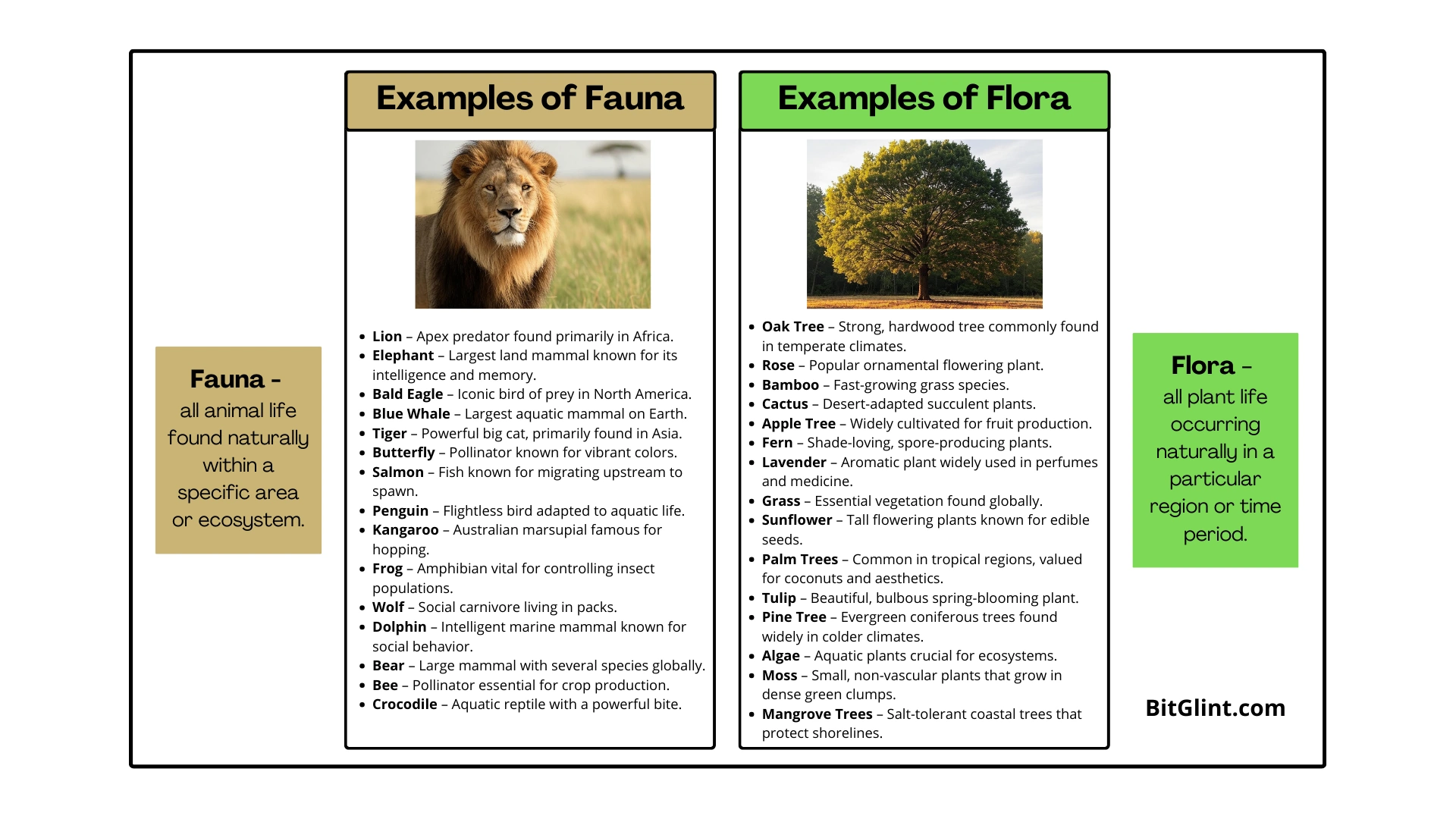Exploring flora and fauna examples is one of the best ways to understand how diverse and connected life on Earth truly is. Plants and animals don’t just coexist; they depend on each other and shape the environments around us. From vibrant flowers in your garden to wildlife in distant forests, becoming familiar with different flora and fauna enriches your appreciation of nature. In this article, you’ll find simple definitions, clear explanations of their types, and 30 helpful examples of flora and fauna to guide your learning journey.

What Are Flora and Fauna?
- Flora refers to all plant life occurring naturally in a particular region or time period.
- Fauna denotes all animal life found naturally within a specific area or ecosystem.
Types of Flora
- Native Flora: Plants naturally occurring in a region.
- Agricultural Flora: Plants cultivated for food and economic benefits.
- Horticultural Flora: Plants grown for decoration or gardening.
Types of Fauna
- Terrestrial Fauna: Animals living primarily on land.
- Aquatic Fauna: Animals living in water bodies.
- Avian Fauna: Bird species of a region.
15 Examples of Flora
- Oak Tree – Strong, hardwood tree commonly found in temperate climates.
- Rose – Popular ornamental flowering plant.
- Bamboo – Fast-growing grass species.
- Cactus – Desert-adapted succulent plants.
- Apple Tree – Widely cultivated for fruit production.
- Fern – Shade-loving, spore-producing plants.
- Lavender – Aromatic plant widely used in perfumes and medicine.
- Grass – Essential vegetation found globally.
- Sunflower – Tall flowering plants known for edible seeds.
- Palm Trees – Common in tropical regions, valued for coconuts and aesthetics.
- Tulip – Beautiful, bulbous spring-blooming plant.
- Pine Tree – Evergreen coniferous trees found widely in colder climates.
- Algae – Aquatic plants crucial for ecosystems.
- Moss – Small, non-vascular plants that grow in dense green clumps.
- Mangrove Trees – Salt-tolerant coastal trees that protect shorelines.
15 Examples of Fauna
- Lion – Apex predator found primarily in Africa.
- Elephant – Largest land mammal known for its intelligence and memory.
- Bald Eagle – Iconic bird of prey in North America.
- Blue Whale – Largest aquatic mammal on Earth.
- Tiger – Powerful big cat, primarily found in Asia.
- Butterfly – Pollinator known for vibrant colors.
- Salmon – Fish known for migrating upstream to spawn.
- Penguin – Flightless bird adapted to aquatic life.
- Kangaroo – Australian marsupial famous for hopping.
- Frog – Amphibian vital for controlling insect populations.
- Wolf – Social carnivore living in packs.
- Dolphin – Intelligent marine mammal known for social behavior.
- Bear – Large mammal with several species globally.
- Bee – Pollinator essential for crop production.
- Crocodile – Aquatic reptile with a powerful bite.
What is Flora?
Flora refers to all plant life that naturally grows in a specific region, habitat, or period. It includes trees, flowers, grasses, shrubs, and all other types of vegetation. Flora can be found in forests, deserts, wetlands, mountains, and even underwater. Some plants grow naturally without human influence, while others are cultivated for food, medicine, or decoration.
Flora is essential for life on Earth. Plants produce oxygen, provide food, and support ecosystems by offering shelter and nutrients to animals. Different regions have unique flora based on climate, soil, and geography. For example, tropical rainforests are home to dense, diverse plant species, while deserts have drought-resistant plants like cacti.
What is Fauna?
Fauna refers to all animal life that naturally exists in a specific region, habitat, or period. It includes mammals, birds, reptiles, amphibians, fish, insects, and other living creatures. Fauna can be found in forests, oceans, grasslands, mountains, and even underground. Unlike domesticated animals, wild fauna survive on their own, adapting to their environment for food, shelter, and reproduction.
Animals play a crucial role in ecosystems. They help control populations of other species, spread seeds, and contribute to the balance of nature. Different regions have unique fauna based on climate and geography. For example, the African savanna is home to lions and elephants, while the Arctic is inhabited by polar bears and seals.
More Examples of Flora
- Maple Tree – Known for colorful leaves in autumn; famous for producing maple syrup.
- Banana Plant – Tropical plant widely grown for its nutritious fruit.
- Dandelion – Common flowering weed valued for its medicinal benefits.
- Cherry Blossom Tree – Flowering tree famous for beautiful pink blossoms.
- Mint – Fragrant herb popular in cooking and teas.
- Corn Plant – Important agricultural crop grown worldwide for food.
- Lilac Bush – Hardy shrub recognized by its fragrant purple flowers.
- Rice Plant – Essential cereal plant feeding billions globally.
- Pumpkin Vine – Seasonal plant producing large edible fruits popular in autumn.
- Coffee Plant – Cultivated widely in tropical regions, source of coffee beans.
- Willow Tree – Graceful trees often found near water sources, known for flexible branches.
- Strawberry Plant – Commonly grown for its sweet berries.
- Aloe Vera – Succulent plant with medicinal uses, particularly for skin care.
- Potato Plant – Crucial food crop grown extensively for its nutritious tubers.
- Orchid – Attractive flowering plant highly valued for decorative purposes.
More Examples of Fauna
- Giraffe – Tallest animal on Earth, known for its exceptionally long neck.
- Owl – Nocturnal bird famous for excellent night vision and quiet flight.
- Sea Turtle – Marine reptile known for long migrations and laying eggs on beaches.
- Horse – Domesticated animal widely used for transportation, farming, and recreation.
- Koala – Tree-dwelling marsupial native to Australia, known for eating eucalyptus leaves.
- Shark – Powerful aquatic predator essential for ocean ecosystem balance.
- Rabbit – Small mammal famous for rapid reproduction and adaptability.
- Chimpanzee – Intelligent primate sharing much of its DNA (98.8%) with humans.
- Parrot – Brightly colored bird known for mimicking human speech.
- Deer – Common herbivore recognized by antlers in many species.
- Octopus – Aquatic creature celebrated for intelligence and unique camouflage skills.
- Snake – Reptile important for controlling pest populations.
- Bat – The only flying mammal, essential for pollination and insect control.
- Ant – Insect known for its cooperative colonies and strength relative to size.
- Zebra – African mammal distinguished by distinctive black-and-white stripes, important for ecosystem health
The Meaning of Wild Fauna and Flora
Wild fauna and flora refer to plants and animals that grow and live naturally in the wild without human interference. These species thrive in forests, grasslands, mountains, rivers, and oceans, shaping ecosystems in countless ways. Unlike domesticated plants and animals, wild flora and fauna survive on their own, adapting to changing environments over time.
Wild flora includes native trees, flowers, shrubs, and grasses that grow naturally in a specific region. Examples include oak trees in temperate forests, cacti in deserts, and mangroves along coastlines. These plants provide food, shelter, and oxygen, making life possible for many animal species.
Wild fauna consists of animals that live freely in nature, from large predators like lions and wolves to tiny creatures like insects and fish. Some wild animals migrate across vast distances, while others stay in one habitat for life. Unlike pets or farm animals, wild fauna hunt, forage, and survive without human care.
Wild flora and fauna are found everywhere, from the deepest oceans to the highest mountains. Whether it’s a hummingbird feeding on wildflowers or a herd of elephants roaming the savanna, these species play a vital role in keeping nature balanced.
Understanding wild flora and fauna helps us appreciate the natural world and recognize the importance of protecting the plants and animals that exist beyond human influence.
Read also: Commensalism: 20 Examples & Definition
The Most Popular on BitGlint

Top 100 Personal Items List
Everyone uses personal items in their daily lives, often without even thinking about them. From the moment you wake up...

30 Defiance Examples & Meaning
Defiance is something most people experience at some point in life. You feel it when you say no to something that...

Top 30 Desire Examples & Definition
Desire is a powerful force that drives much of human behavior, shaping our goals, dreams, and everyday decisions. It's...

100 Non-Digital Things List
In everyday life, there are still hundreds of objects, tools, and materials that exist completely outside the digital...

30 Examples of Attention & Definition
Have you ever noticed how a catchy tune can grab your attention, even when you're busy doing something else? It's...

60 Cultural Traditions Examples & Definition
Cultural traditions are part of daily life - whether people realize it or not. They shape what we eat, how we...

Top 30 Intimacy Examples & Meaning
Intimacy goes beyond physical touch or romantic moments. It’s about closeness, trust, and connection. In everyday...
Get Inspired with BitGlint
The Latest
40 Emotional Value Examples & Meaning
Why do some messages stick — while others are forgotten? Why do people choose one brand over another, even when the product is the same? The answer often comes down to emotional value. Emotional value is what makes a message feel human. It’s the emotional connection...

30 Teasing Examples & Definition
Teasing is a common part of human interaction. People tease in different ways, for different reasons. Sometimes it is friendly. Sometimes it can hurt feelings. Understanding what teasing means and seeing clear examples helps everyone handle these moments better....
40 Thought Experiments for Curious Minds
Some questions can’t be answered with a simple yes or no. Some problems don’t have a clear solution. That’s where thought experiments come in. They aren’t just old ideas from philosophy books. Thought experiments are tools we still use to think through problems, test...
20 Political Tensions Examples & Definition
Political tensions are a part of our everyday lives, even if we don't always notice them. Think about a heated debate at a family dinner or a disagreement between friends over a controversial topic. These small-scale conflicts reflect the larger political tensions...

